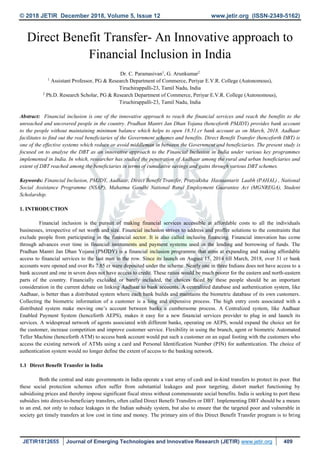This document discusses direct benefit transfer (DBT) as an innovative approach to financial inclusion in India. It analyzes DBT's role in reducing intermediaries between the government and beneficiaries. Key DBT programs implemented in India include PAHAL for LPG subsidies, the National Social Assistance Program, MGNREGA, and student scholarships. DBT aims to increase transparency and reduce leakage by directly depositing benefits into citizens' bank accounts linked to Aadhaar numbers. Over 433 central government schemes from 46 ministries have implemented DBT as of November 2018.









![© 2018 JETIR December 2018, Volume 5, Issue 12 www.jetir.org (ISSN-2349-5162)
JETIR1812655 Journal of Emerging Technologies and Innovative Research (JETIR) www.jetir.org 418
are 8 states which reached above 100 percent achievement out of 36 states. There are 5 states has below 80 percent with Aadhaar
penetration, the state of Maghalaya and Assam has very low penetration of Aadhaar into 28 and 11 respectively.
4. CONCLUSION AND SUGGESTIONS
When financial inclusion was introduced in India, there was a problem to find out the real beneficiaries and their status.
But it has been practiced with the help of information and communication technology. Direct Benefit Transfer is one of the
innovative ways to reach the benefits without any intermediators or machinery under this methods, benefit, schemes, incentives
and assistance will reach directly to the beneficiaries’ bank account. Therefore, if the Direct Benefit Transfer should be effective,
there is a need of linking of bank account and Aadhaar cards through digital format. Direct Benefit Transfer is playing a
significant role in the field of financial inclusion in India
REFERENCES
[1] Singh, Ravindra. & Nisha, (2014). Financial Inclusion and Economic Growth in India – A Theoretical Framework,
International Research Journal of Management Sociology and Humanity (IRJMSH), Volume 5, Issue 5, online ISSN
2277-9809, pp 131-138J.
[2] Paramasivan C and Ganeshkumar V (2013), “Overview of Financial Inclusion in India” International Journal of
Management and Development Studies Volume No. 2 (2013), Issue No. 3 (March) ISSN (Online): 2320-0685.
[3] Santosh K, Subrahmanyam SVE, Narayana Reddy T. “Major Milestones of Financial Inclusion in India-An Analytical
Study,” International Journal of Advanced Scientific Research & Development. e-ISSN:2395-6089.pISSN: 2394-8906.
2016; 3(3):24-34.
[4] Kumar Bijoy (2018), “Financial Inclusion in India and PMJDY: A Critical Review” International Conference on
Information Technology and Knowledge Management pp. 39–46 DOI: 10.15439/2018KM32 ISSN 2300-5963 ACSIS,
Vol. 14.
[5] Neha Sharma (2017), “Impact Of Direct Cash Transfer In Lieu Of Public Distribution System: A Policy Review Of
Chandigarh ,India”. International Journal of Scientific & Engineering Research Volume 8, Issue 6, June-2017 1189
ISSN 2229-5518.
[6] Assocham (2017), Economy Aadhaar helped disburse Rs 83,000 crore via Direct Benefit Transfer. Financialexpress,
Edition Delhi Published: August 27, 2017.
[7] Rajasekaran N (2018), “Including the Excluded: The Scenario of Financial Inclusion in India” IOSR Journal of
Business and Management (IOSR-JBM) e-ISSN: 2278-487X, p-ISSN: 2319-7668. Volume 20, Issue 2. Ver. VII
(February. 2018), PP 64-69
[8] Aman Sharma (2018), Savings from direct benefit transfer pegged at Rs 83,000 crore. The Economic Times, Edition
Delhi.
[9] Sakthivel N and Mayilsamy R (2018), “Direct benefits transfer schemes with special reference to LPG (PAHAL)
scheme in Coimbatore district” International Journal of Commerce and management research , ISSN: 2455-1627
Impact Factor: RJIF 5.22, Volume 4; Issue 1; January 2018; Page No. 44-47
[10] Korde, Pandurang,” Direct Benefit Transfer Scheme: Issues and Challenges”, Journal of Research in Management and
Technology, Volume 4, Issue 1 (January, 2015).
[11] Kumar (2015),” Customer satisfaction from PAHAL scheme among LPG customer”. Worldwide journal of
Multidisciplinary Research and Development.
[12] Mani Goswami (2016), “A study of financial inclusion initiatives in India” XVII Annual International Seminar
Proceedings; January, 2016.
[13] Selvam V and Velmurugan G (2015), “An Empirical Study on DBT Awareness”, ISSN 2039-2117 (online) ISSN
2039-9340 (print) Mediterranean Journal of Social Sciences MCSER Publishing, Rome-Italy Vol 6 No 5 September
2015.
WEBSITE
[1] www.pmjdy.gov.in
[2] www.dbtbharat.gov.in
[3] www.uidai.gov.in
[4] www.worldbank.org
[5] www.rbi.org.in
[6] www.iimb.ac.in
[7] www.financialservices.gov.in
[8] www.crisil.com](https://image.slidesharecdn.com/jetir1812655-190115141956/85/Jetir1812655-10-320.jpg)